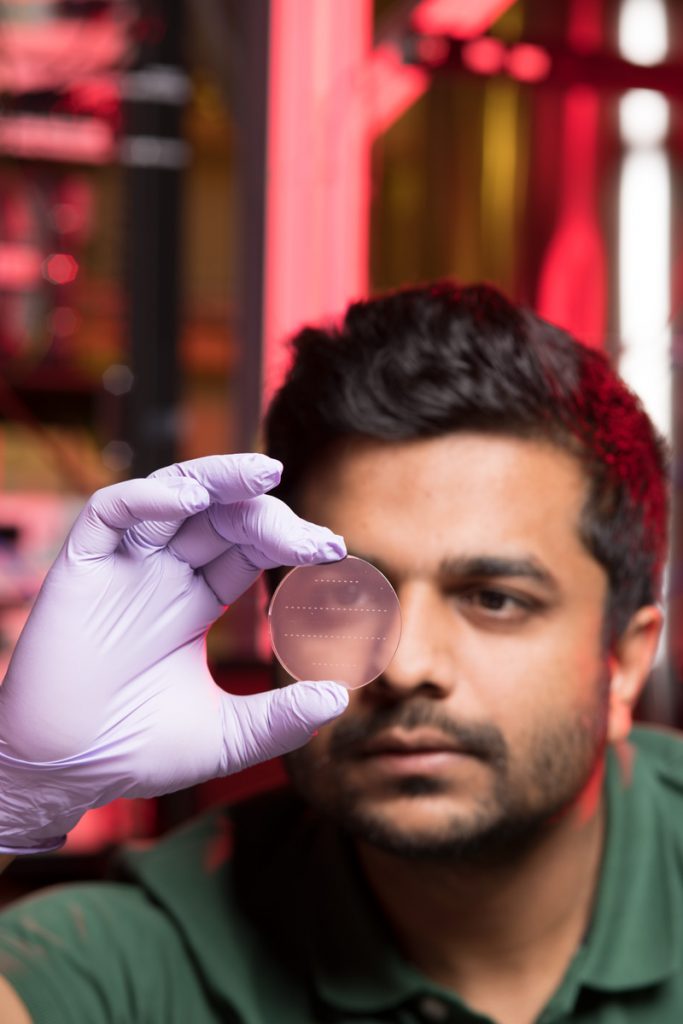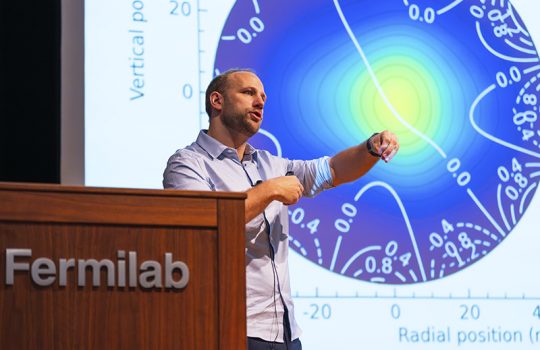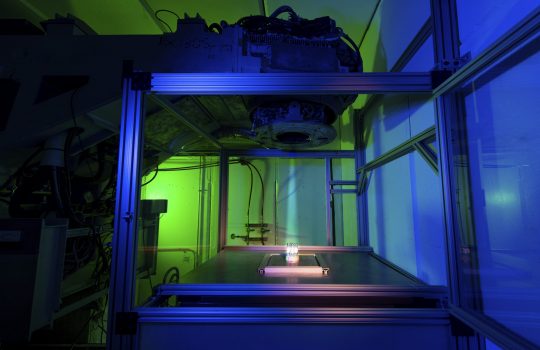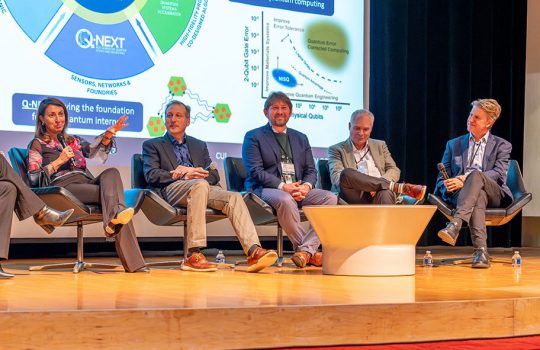Scientists cannot observe dark matter directly, so to “see” it, they look for signals that it has interacted with other matter by creating a visible photon. However, signals from dark matter are incredibly weak. If scientists can make a particle detector more receptive to these signals, they can increase the likelihood of discovery and decrease the time to get there. One way to do this is to stimulate the emission of photons.

Former University of Chicago graduate student Ankur Agrawal worked with scientists and engineers at Fermilab and the University of Chicago on his doctoral thesis research subject, “Stimulated emission of signal photons from dark matter waves.” Photo: Reidar Hahn, Fermilab
Scientists at the U.S. Department of Energy’s Fermi National Accelerator Laboratory and University of Chicago reported the ability to enhance the signals from dark matter waves by a factor of 2.78 using novel quantum techniques. This technology demonstrates how advances in quantum information science can be applied, not only to quantum computing applications, but also to new physics discoveries.
This exciting result was made possible by the DOE’s Quantum Information Science Enabled Discovery program, and the Heising-Simons Foundation. University of Chicago graduate student Ankur Agrawal conducted this research for his doctoral thesis supervised by Fermilab scientist Aaron Chou in collaboration with members of Professor David Schuster’s group at the University of Chicago. The results were recently published in Physical Review Letters.
For this experiment, the researchers first prepared a microwave cavity in a special quantum state. Then, they used superconducting quantum bits, or qubits, to increase the measurement sensitivity within that cavity so they could more easily detect any signals indicating the presence of dark matter.
“There are two ways to speed up an experiment; you can gather more signal or reduce noise,” said Schuster. “In this experiment we used a qubit to do both, preparing a quantum state of light that stimulates the creation of photons, and then using the qubit to probe the exact number of photons multiple times without destroying any to eliminate excess noise.”
The researchers prepared the microwave cavity using superconducting qubits in what is known as a Fock state. These quantum Fock states have a well-defined number of photons, and the higher the Fock state, the more likely it is that dark matter will interact. By preparing the cavity this way, as dark matter passes through the microwave cavity wall, the interaction will cause an extra photon produced by dark matter to be pumped into or removed from the cavity. The presence of one more or one less photon indicates that the photon was stimulated by dark matter.
“This experiment is a beautiful demonstration of one of the first things we learn in a quantum mechanics course about quantum states, and the results confirm what I learned,” said Agrawal.
The second part of the experiment involved engineering the interaction between the qubit and the cavity in such a way as to reduce the noise. At microwave frequencies, each photon has a tiny amount of energy which makes them very sensitive to the noise from the surrounding environment. To minimize the thermal photons from overwhelming the signal, researchers cool this cavity with a dilution refrigerator where the temperature is one-one-hundredth of a Kelvin—100 times colder than outer space.
Using superconducting qubits enabled them to engineer the interaction in such a way as to reduce the noise to extremely low levels, thereby increasing sensitivity.
“For this technique, we engineer the qubit-photon interaction so that the photon is not destroyed in the process of measurement,” said Akash Dixit, a scientist who was part of the research team at Fermilab. “This allows us to measure the same photon many times which reduces the influence of noise and increases our sensitivity to these rare events.”

Akash Dixit, a former University of Chicago postdoctoral researcher, participated in the project at Fermilab to stimulate photon emission. Photo: Ryan Postel, Fermilab
The overall technique is like pushing a child on a swing. If the child is not swinging, you need to push her much harder to get her moving; but if the swing is already swinging, you don’t have to push as hard.
“What we do is take the electromagnetic field in our microwave cavity or detector — the swing — and get it to start swinging so that it can more easily take pushes from the dark matter that’s passing by,” said Chou. “This process of stimulated emission is actually exactly how lasers work.”
Previous experiments started with a zero, or ground-state, field inside the cavity, the equivalent of the swing standing still.
“Scientists can use this technique to increase sensitivity to advance their search for dark matter, saving time and resources and to explore other mysteries of fundamental science,” said Agrawal.
Fermi National Accelerator Laboratory is supported by the Office of Science of the U.S. Department of Energy. The Office of Science is the single largest supporter of basic research in the physical sciences in the United States and is working to address some of the most pressing challenges of our time. For more information, please visit science.energy.gov.



